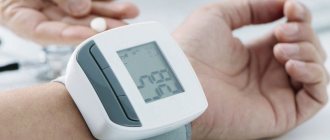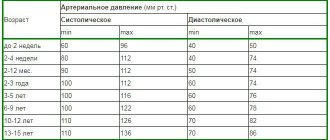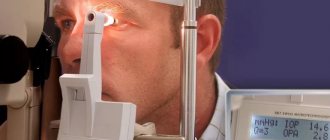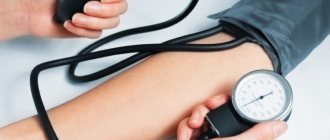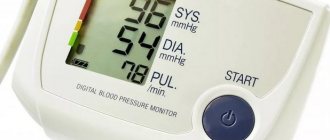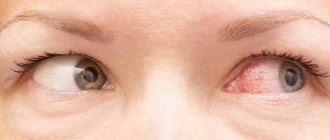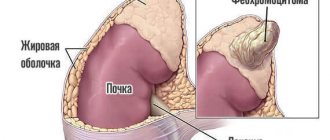Signs of high blood pressure
How can you tell if your blood pressure has increased or decreased? To do this, you need to know a number of characteristic signs of both hypertension and hypotension. The state of health of a sick person with high and low blood pressure is very different.
Exceeding blood pressure is hypertension. This pathology, for the most part, is a primary disease that occurs against the background of disturbances in the functioning of the cardiovascular system, as well as sudden disruptions in water-salt metabolism. Only in 10% of cases, high blood pressure is a consequence of pathologies of the kidneys and endocrine system.
The first thing you need to pay attention to in order to distinguish high blood pressure from hypotension is the indicators. You need to use a tonometer.
With hypertension, the level will exceed 130/90. It should be noted that each person has his own normal limit, so it is important to know your usual indicators.
Since it is not always possible to use a tonometer, it is important to know what signs and how to determine high blood pressure. Modern experts identify several characteristic symptoms of hypertension:
- Pain syndrome in the occipital and temporal lobe.
- Sensation of pulsation and increased impact on the skull.
- Dizziness when moving your head suddenly.
- Possible severe visual impairment: the appearance of “spots”.
- Intense attacks of nausea, vomiting.
- Malfunctions of the hearing organs, the occurrence of noise, hum, the manifestation of the so-called ringing in the ears.
With concomitant ischemic disease, the heart rate may increase and pain in the chest area may occur. The presence of even several symptoms from the above list indicates increased blood pressure. A patient with hypertension, as a rule, has a dense physique and physical inactivity, but these signs are not always necessary. This pathology develops most often after 35 years.
Myths are dispelled by leading medical experts
“Cardiovascular disease is a risk factor for more severe infection and, accordingly, adverse outcomes. Vaccination is the main protection against COVID-19, and possible adverse reactions to vaccination are not comparable to the real risks and possible severe course of the infection that arise due to the presence of concomitant diseases of the circulatory system,” noted the General Director of the Federal State Budgetary Institution “National Medical Research Center of Cardiology” of the Ministry of Health of Russia, Chief freelance specialist cardiologist of the Russian Ministry of Health of the Central, Ural, Siberian and Far Eastern Federal Districts, Sergey Anatolyevich Boytsov.
Elderly people and people with concomitant diseases suffer the most from coronavirus, among whom a large group are patients with cardiovascular, cerebrovascular diseases and diabetes.
Such patients are at high risk of severe COVID-19 infection and have a worse prognosis. “People with diabetes are at increased risk of contracting coronavirus. However, among diabetic patients there is an opinion that if a patient has high blood sugar, then he should not be vaccinated. In fact, people with this concomitant disease, as well as those with cardiovascular pathologies, need to be vaccinated first! Only vaccination can save you from possible risks associated with coronavirus infection,” said Marina Vladimirovna Shestakova, Deputy Director and Director of the Institute of Diabetes of the Federal State Budgetary Institution “National Medical Research Center for Endocrinology” of the Russian Ministry of Health.
“The risk of developing cardiovascular complications after receiving a COVID-19 vaccine is 1 in 1,000,000, while the risk of complications and death from COVID-19 is disproportionately higher. Moreover, if patients with COVID-19 have arterial hypertension, the risk of death is 2.5 times higher, and if they have coronary heart disease, the risk is 5 times higher. This is why it is so important for absolutely everyone, and especially patients with cardiovascular diseases, to get vaccinated. We need to be afraid not of the vaccine, but of the new coronavirus infection, its life-threatening complications and long-term consequences. Nana Vachikovna Pogosova , Deputy Director General for Scientific Analytical Work and Preventive Cardiology of the National Medical Research Center of Cardiology of the Russian Ministry of Health
“Many people say that immunity after an infection is better than after vaccination, and this is true. However, no one says that after a coronavirus infection you can NOT survive, BECOME disabled or significantly reduce your quality of life! Everyone looks at the side effects of vaccination under a magnifying glass, but they don’t notice its benefits,” noted Antonina Aleksandrovna Ploskireva, Deputy Director for Clinical Work of the Central Research Institute of Epidemiology of Rospotrebnadzor.
“For 8 years, within the framework of the social and educational program “Pulse of Life,” Bayer has been carrying out projects aimed at increasing the level of knowledge of the population about the risks associated with CVDs. During a pandemic, issues of CVD prevention become especially acute, so we actively support programs to popularize the most effective tool in the fight against COVID-19 – vaccination. We also consider it important to conduct information campaigns not only for the population, but also for our employees: now the vaccination rate at Bayer exceeds 60%,” commented Irina Nikolaevna Lavrova, director of communications, relations with government and public organizations and sustainable development at Bayer.
In 2021, as part of the Pulse of Life program with the support of the Russian Society of Cardiology (RSC), the online test “Measure the age of your heart!” was launched, which was completed 198,000 times. The test is designed to warn about possible risks of cardiovascular diseases and encourage people to take the necessary preventive measures. The online test is available for passing at the link: https://www.heartbeatrussia.ru/en/node/231
Signs of low blood pressure
It is quite important to distinguish high blood pressure from low blood pressure, since hypotension also has a list of symptoms. In addition, the lack of timely help for low blood pressure can lead to serious complications. Hypotension is characterized by a decrease in blood pressure to 100/65 mmHg. Often these indicators are the only sign of physiological hypotension, which is practically asymptomatic.
A person with low blood pressure usually has a thin build and is pale. Hypotension most often affects women at a young age, starting in adolescence.
In other forms of pathology, characteristic signs are observed. One of the very first manifestations is morning dizziness and weakness. With hypotension, a person feels a constant feeling of lethargy, is susceptible to various ailments, and when standing up suddenly, severe dizziness and “darkness” occur in the eyes. In addition, the following symptoms indicate low blood pressure:
- Short-term, regular loss of consciousness. A similar manifestation of low blood pressure occurs among the young age group.
- Attacks of nausea and vomiting are one of the common signs that may indicate high or low blood pressure. It is not recommended to focus only on this factor.
- Cold hands and feet.
- An apathetic state, the manifestation of photosensitivity, decreased performance, a feeling of weakness are some of the most striking components indicating the possible development of hypotension.
It should be noted that such symptoms may indicate the development of other dangerous diseases. Therefore, only a professional doctor can reliably make a diagnosis. In this regard, if such signs appear, it is important to promptly seek help and begin treatment. Advanced hypertension is a serious health risk.
Positive point
The study also revealed what positive changes have occurred in people's lives during the pandemic.
The majority of respondents noted that they began to devote more time to their health (26%), began to communicate more often with loved ones (22%), began to work remotely (19%) and engage in their favorite hobbies (17%). ______________ Information about the survey
In September 2021, the research and consulting company IFORS conducted an online survey of 1,208 able-bodied people aged 21 to 60 living in various federal districts of Russia to find out the popularity of myths about vaccination against coronavirus infection. The survey consisted of 12 questions aimed at identifying the most popular myths about vaccination, identifying the sources of myths and the degree of trust in them, studying myths about vaccination related to cardiovascular diseases and positive changes in people's lives during the pandemic.
Dangerous symptoms
A fairly intense, sharp “jump” in downward pressure often develops against the background of a specific cause. This could be an allergic reaction, an acute infectious disease, intoxication of the body, large blood loss, or disruption of the cardiovascular system. In such cases, the person becomes intensely and quickly pale and may lose consciousness. A short-term decrease in pressure gradually returns to normal in a horizontal position. If there is no improvement while lying down, you need to get first aid and try to independently maintain your blood pressure level with the help of medications until the doctors arrive.
- Anticholinergic drugs.
- Medicines that stimulate the central nervous system.
- For acute crises and fainting - alpha-adrenergic agonists.
A sharp increase usually develops against the background of hypertension and requires timely therapeutic intervention - this is taking prescribed medications, calling an ambulance. Few people know that high blood pressure is an extremely dangerous pathology that can lead to dangerous complications.
A “jump” in indicators for hypertension occurs against the background of excessive physical and psychological stress, as a complication of pathologies of the endocrine system and chronic kidney diseases.
With a significant increase in indicators several times, the load on the vessels increases, which often leads to their rupture, and, as a consequence, internal hemorrhage. Most often, such lesions are localized in the retina and brain (hemorrhagic stroke). If your blood pressure increases, it is best to seek professional help.
How to determine high or low blood pressure is one of the pressing issues that almost every person has to face in life. The most effective way to determine indicators is to use a special device (tonometer). But it is not always possible to use this device. In this regard, it is extremely important to know the characteristic features of high and low blood pressure. Since the lack of timely treatment for hypertension can lead to the development of serious complications in the human body, in some cases attacks associated with pressure lead to death.
What are we afraid of?
37%
- die from the vaccine
36%
- ineffectiveness of vaccines because they were created “too quickly”
33%
- uselessness of vaccines due to the constant mutation of COVID-19 Moreover, it is in relation to cardiovascular diseases that there are a greater number of different prejudices associated with vaccination, for example:
14 %
- vaccines often “cause inflammation of the heart”
27%
- after vaccination there is a high incidence of thrombosis and ischemic stroke
29%
- those who are vaccinated have an increased risk of dying from a stroke
34%
- people with cardiovascular diseases should not be vaccinated against COVID-19 at all
Stages of hypertension
For each person, the blood pressure norm is individual. However, the diagnosis of hypertension is most often made when, after measuring blood pressure on two different days, the systolic pressure is equal to or greater than 120 mmHg. Art. and/or the diastolic pressure value is equal to or greater than 80 mmHg. Art.
In this case, high pressure has its own degrees:
- I degree - increase in systolic pressure from 139 to 159 mm Hg. art (diastolic oscillation interval - 90-99 mm Hg);
- II degree - increase in systolic pressure from 160 to 170 mm Hg. Art. (diastolic oscillation interval - 100-109 mm Hg);
- III degree - pressure rises above 180 mm Hg. Art.
There are three stages of hypertension:
- Stage I – mild, blood pressure rises briefly and irregularly, normalizes under favorable conditions; no target organ damage is observed.
- Stage II – moderate, high blood pressure can only be reduced with the help of medications; There is damage to target organs: the heart, kidneys, brain, as well as blood vessels, including the eyes.
- Stage III – severe, target organ damage occurs with thrombosis, heart attacks and strokes.
How to live with low blood pressure?
Photo from fepblue.org
First of all, a person with hypotension needs to get enough sleep. Some experts advise sleeping up to 10 hours a day, but certainly not less than 8. You need to sleep in a position with your head elevated higher than usual (it is recommended to place something under the legs of the bed to raise its upper edge).
It is also important to follow a diet. Eat small meals more often. Food should be well salted. Reduce carbohydrates in your diet. Try to rest after eating.
Drink plenty of fluids, but avoid alcohol.
Exercise to improve blood circulation, but do not make sudden movements. Do not take a sharply vertical position, do not lift heavy objects.
Keep in mind that the effect of hot water on the body should be short-lived. It is better to take a short shower than to lie in a hot bath for a long time, much less take a steam bath or sauna.
If these measures do not help, your doctor may prescribe a medication, such as midodrine. Supplements such as eleutherococcus or ginseng tincture may also help.
What is hypertension?
Hypertension is high blood pressure. In this condition, blood pressure on the walls of the arteries steadily increases. This can result in changes in the heart muscle, brain and kidneys, increasing the risk of myocardial infarction and stroke.
Blood pressure is determined by the volume of blood the heart pumps and the resistance of blood flow in the arteries. The more blood the heart transports and the narrower the arteries, the higher the blood pressure. Blood pressure is calculated in millimeters of mercury (mmHg) and is measured by two indicators:
- The first or top indicator is systolic pressure. It measures the pressure in the arteries when the heart muscle contracts.
- The second or lower indicator is diastolic pressure. It measures the pressure in the arteries between heartbeats.
Imagine that your body is a multi-story building, and the water pressure in it is blood pressure. If the pressure is weak, then the water does not reach the upper floors. As with low blood pressure, blood does not flow to the brain, and we feel weak or even lose consciousness. But with consistently strong water pressure in the house, pipes and equipment are destroyed over time. Just like arteries with chronically high blood pressure.


